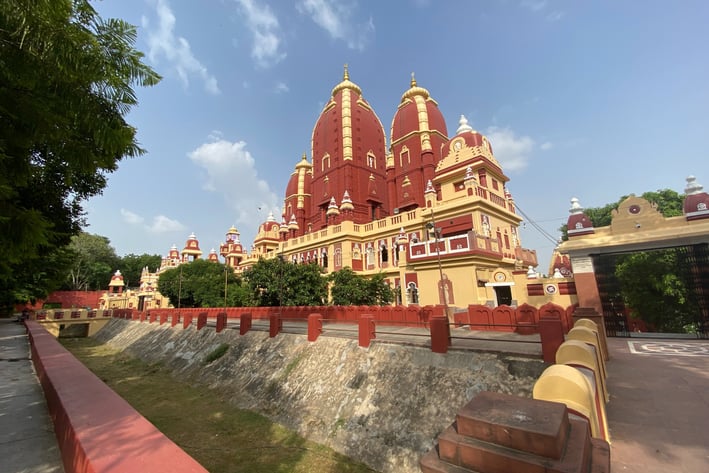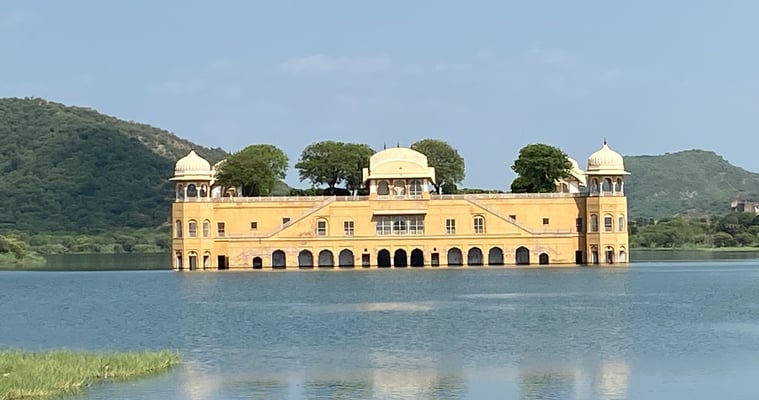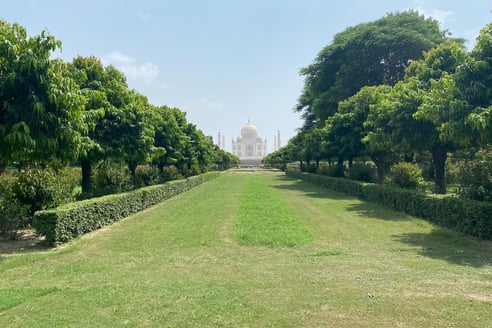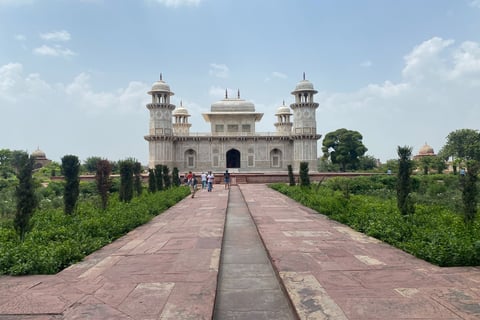Discover epic adventures, insider travel tips, and must-have gear recommendations to make your next trip unforgettable!
Conquering and visiting the Golden Triangle
India’s Golden Triangle is the country’s most famous travel route, covering Delhi, Agra, and Jaipur. It’s the perfect introduction to India’s history, culture, and food, packed with architecture, bustling markets, and UNESCO World Heritage Sites. Here's my guide to visiting the golden triangle!
2/26/202510 min read
🗺️ Golden Triangle India Itinerary
The best time to visit India's Golden Triangle is between October and March when the weather is pleasant, and humidity is low. However, I visited in early September when the monsoon season had just about ended. The rains had mostly cleared, leaving behind lush greenery, but the heat was still intense, and the humidity could be overwhelming at times.
Avoid traveling between May and June, as temperatures soar to unbearable levels. July and August bring heavy monsoon rains, which can make travel difficult. Even in September, I had to take suitable precautions (plenty of suncream and a hat) as well as lots of bottled water to keep hydrated. The heat is unlike anything in the West!
Stop 1: Delhi (Days 1-3)
India’s capital is a mix of ancient Mughal history and modern chaos, packed with UNESCO World Heritage sites, lively markets, and mouth-watering street food. When I first arrived in Delhi, I found it incredibly crowded and bustling with life. The city is chaotic but has an undeniable energy that makes it a thrilling place to explore.
How to Get to Delhi
By Air: Fly into Indira Gandhi International Airport (DEL), one of Asia’s busiest airports
By Train: If traveling from another Indian city, New Delhi Railway Station (NDLS) is well connected with the rest of the country.
Once in Delhi, you can either catch a taxi or travel by metro from the airport. The Airport Express Metro is the best way to reach the city center. It’s far cheaper than a taxi and avoids the hassle of getting ripped off upon arrival. The ride to New Delhi or Old Delhi takes around 25 minutes and costs just £1-£2.
Top Attractions in Delhi
Old Delhi (Mughal Delhi)
Old Delhi is chaotic, loud, and totally captivating—a throwback to the days of Mughal emperors, filled with labyrinthine alleys, sizzling street food, and ancient architecture that whispers centuries of history.
Red Fort (£7)
A massive 17th-century Mughal fortress made of red sandstone. It served as the main residence of the Mughal emperors for nearly 200 years.
As you pass through the Lahori Gate, you’ll enter the Chatta Chowk, a covered bazaar that once sold silks and jewellery to the royal family.
Inside, explore sprawling courtyards, the Diwan-i-Am (Hall of Public Audience), and the Diwan-i-Khas (Hall of Private Audience) with its famous “peacock throne” setting.
Light & Sound Show (£3): In the evening, a narrated show tells the story of Delhi’s past with atmospheric lighting projected onto the fort walls—dramatic, though a bit hot in summer.
Tip: Go early morning or late evening to avoid crowds and the midday heat.
Jama Masjid (Free)
India’s largest mosque and a masterpiece of Indo-Islamic architecture.
Built in 1656 by Shah Jahan (the same guy who built the Taj Mahal), it can hold up to 25,000 worshippers at once.
The courtyard is vast, framed by red sandstone minarets and marble domes.
Climb the southern minaret (£1) for an epic 360° view over Old Delhi—domes, markets, traffic chaos, and even a hazy glimpse of Connaught Place.
Women may be asked to wear a robe provided by the mosque—don't worry, it makes for a fun photo.
Chandni Chowk
Delhi’s most iconic street market, a wild ride for all your senses.
Every turn smells like cardamom, frying oil, or incense.
Sample street food like paratha at Paranthe Wali Gali, mutton korma at Karim’s, or sweet jalebi straight from the fryer.
You'll dodge rickshaws, cows, and endless waves of people.
Hire a cycle rickshaw for a breezy ride through the madness—or better, walk and eat your way through.
Raj Ghat
A serene, open-air memorial where Mahatma Gandhi was cremated in 1948.
The black marble platform is set in a peaceful garden, with an eternal flame burning in his memory.
It’s a place of quiet reflection, often visited by dignitaries and school groups.
Pair this with a walk along the Yamuna River, just a short stroll away.
New Delhi (Colonial Delhi)
Designed by the British in the 20th century, New Delhi has broad boulevards, grand buildings, and a distinctly European feel, but still pulses with Indian soul.
India Gate
A 42-meter-high war memorial dedicated to 70,000 Indian soldiers who died in WWI.
The surrounding lawns are packed with locals in the evening—kids flying kites, couples on dates, and families picnicking.
Street vendors sell roasted peanuts, cotton candy, and glowing toys for kids.
At night, India Gate is beautifully lit, and the nearby Amar Jawan Jyoti (eternal flame) adds emotional depth.
Humayun’s Tomb (£5)
This UNESCO site is a stunning blend of Persian and Mughal architecture, and considered the blueprint for the Taj Mahal.
Built in 1570, it’s surrounded by immaculate Mughal gardens laid out in quadrants (charbagh style).
The red sandstone façade and white marble dome are breathtaking, especially at sunset.
Arrive just after opening (8 AM) to enjoy the gardens and tomb in peace.
Qutub Minar (£5)
A 73-meter-tall sandstone victory tower built in 1193 to celebrate Muslim dominance in Delhi.
The carvings on the tower’s fluted surface are incredibly detailed Arabic verses.
The surrounding complex includes ancient mosques and tombs, plus the Iron Pillar, which hasn’t rusted in over 1,600 years.
Come near golden hour for beautiful light and fewer tour groups.
Lotus Temple (Free)
A symbol of unity and peace, this Baháʼí temple is shaped like a lotus flower rising from water.
It’s a space for quiet prayer and reflection—no ceremonies, no preaching.
The white marble petals are stunning, especially when contrasted against a blue sky.
Silence is enforced inside, making it one of the few truly calm places in Delhi.
Modern Delhi
Where modern temples meet mega malls and nightlife mixes with history.
Akshardham Temple (Free)
An awe-inspiring Hindu temple complex opened in 2005—ornate, massive, and deeply spiritual.
The carvings are mind-blowingly intricate, depicting gods, dancers, animals, and historical scenes.
There’s also a cultural boat ride, lush gardens, and an epic musical fountain show at night (~£2).
Cameras and phones are not allowed inside—lockers are provided, but come prepared.
Connaught Place (CP)
A circular shopping district with colonial buildings, tree-lined avenues, and everything from H&M to authentic Indian cafes.
Great for grabbing lunch, shopping for souvenirs, or bar hopping after dark.
Don’t miss Wenger’s Bakery (serving pastries since 1926) or Saravana Bhavan for affordable South Indian food.
The underground Palika Bazaar is fun if you're hunting for bargains—but expect some haggling!
Best Lunch Experience: Local Mess Canteens
One of the best ways to enjoy lunch in Delhi is in a local mess canteen, where staff reload your plates continuously. It only costs £1 for an all-you-can-eat meal, but you’ll need to get your elbows out at the table and be prepared to eat quickly alongside locals. The food is fresh, authentic, and incredibly filling.
Where to Stay in Delhi
Budget: Zostel Delhi (£10/night, hostel).
Mid-Range: Bloomrooms @ New Delhi Railway Station (£40/night). The rooms are compact but modern, with bright yellow interiors and incredibly comfortable beds. The staff were friendly, and it was a great place to retreat to after the chaos of Delhi.
Luxury: The Imperial (~£250/night, a colonial-era 5-star hotel).
Stop 2: Agra (Days 4-5)
Agra, located in the northern Indian state of Uttar Pradesh, was once the majestic capital of the Mughal Empire, and it remains one of the most culturally rich and historically significant cities in India. The architecture here reflects centuries of Islamic, Persian, and Indian influence, with red sandstone forts, intricate marble mausoleums, and lush royal gardens.
Despite the chaos and traffic of modern Agra, the city offers moments of absolute awe and serenity, especially at sunrise or sunset by the Yamuna River.
Top Attractions in Agra
Taj Mahal (£12)
Status: UNESCO World Heritage Site
Best Time to Visit: Sunrise for the fewest crowds and soft golden light
The Taj Mahal is not just India’s most iconic monument—it's a symbol of eternal love, built by Mughal Emperor Shah Jahan in memory of his wife Mumtaz Mahal.
Seeing it in person feels almost dreamlike. The entire complex is a masterpiece of symmetry and craftsmanship—white marble inlaid with semi-precious stones like lapis lazuli, jade, and turquoise. From afar, it glows; up close, the delicate floral designs and Quranic inscriptions are mesmerising.
Sunrise Experience: We arrived before the gates opened and queued with a small group of excited early risers. As the first rays of light hit the dome, it felt like the whole monument shimmered. The reflection in the long pools of water adds to the magic.
Photo Tip: Walk straight to the raised marble platform to
capture an uninterrupted photo before the crowds arrive.
Women must cover their shoulders and knees; scarves and long pants are ideal.
Shoes must be removed or covered at the marble platform.
Agra Fort (£8)
Status: UNESCO World Heritage Site
Duration: ~2 hours to explore fully
Located just 2.5 km from the Taj, Agra Fort is an enormous 16th-century fortress made of red sandstone and white marble. It was a royal residence, military stronghold, and eventually the prison of Emperor Shah Jahan, who was confined here by his son.
Inside, you'll find elegant halls, courtyards, and intricate carvings. The Musamman Burj, a marble tower overlooking the Yamuna, offers a hauntingly beautiful view of the Taj Mahal—where Shah Jahan is said to have spent his final days gazing at the tomb of his beloved wife.
Highlights Inside Agra Fort:
Diwan-i-Am (Hall of Public Audience)
Diwan-i-Khas (Hall of Private Audience)
Sheesh Mahal (Palace of Mirrors)
Khas Mahal (Emperor’s bedroom with Taj view)
Go with a licensed guide or audio tour to truly appreciate the history and symbolism.
Mehtab Bagh (£2)
Duration: ~1 hour
Best Time: Sunset
This serene garden complex lies directly across the Yamuna River from the Taj Mahal, perfectly aligned with its central dome. It was originally built by Emperor Babur and later restored to serve as a romantic viewing spot. Unlike the main Taj Mahal entrance, this place is rarely crowded.
As the sun sets behind the dome, photographers and couples alike gather for peaceful views and quiet moments away from the chaos of Agra.
📸 Great spot for long-exposure shots and crowd-free selfies.
Bonus Sights (if You Have time):
Itimad-ud-Daulah's Tomb ("Baby Taj") – A beautiful marble tomb often considered a draft version of the Taj Mahal.
Kinari Bazaar – A bustling local market where you can shop for jewellery, sarees, spices, and handicrafts.
Fatehpur Sikri (Day Trip) – A red sandstone ghost city and former Mughal capital located about an hour outside Agra. Fascinating history, and often overlooked!
Where to Stay in Agra
Staying close to the Taj Mahal’s East or South Gate is ideal, especially for early morning visits. Many hotels even offer rooftop views of the monument.
Budget: Zostel Agra – £8–12/night:A lively, well-kept backpacker hostel with a rooftop view of the Taj and a great café.
Mid-Range: Coral Tree Homestay – £30–50/night: A charming, family-run stay just 10 minutes from the Taj East Gate. The hospitality is amazing, and breakfast is homemade and delicious.
Luxury: The Oberoi Amarvilas – £250+/night: Pure royal treatment. Every room has a private balcony with a direct view of the Taj Mahal. Think infinity pools, marble bathtubs, and candlelit dinners in view of the dome.
Splurge here if you're celebrating something special—it's one of the most luxurious stays in all of India.
Stop 3: Jaipur (Days 5-7)
Jaipur, Rajasthan’s capital, is a city of majestic forts, elaborate palaces, and chaotic charm—all bathed in a warm pink hue that gives it its nickname, the "Pink City." With a mix of royal heritage, vibrant street markets, and centuries-old architecture, Jaipur is one of the crown jewels of India's Golden Triangle.
Top Attractions in Jaipur
Amer Fort (Amber Fort) – £8
Perched on a hill just outside the city, Amer Fort is a colossal 16th-century fortress built with red sandstone and marble. Inside, you'll find ornate halls, mirror-covered chambers, and sweeping courtyards.
Highlights:
Sheesh Mahal (Mirror Palace): A dazzling hall where a single candle reflects a thousand times.
Ganesh Pol: A beautifully painted gate that’s Instagram-famous.
Elephant Ride (optional): Tourist-friendly but controversial—walk or jeep is a more ethical option.
Go early to beat the heat and crowds. Wear comfy shoes—lots of stairs and uneven stone paths.
Hawa Mahal (Palace of Winds) – £3
This honeycomb-like structure is one of Jaipur’s most iconic buildings. With 953 tiny windows (called jharokhas), it was built so royal women could watch street festivals without being seen.
Photo Tip: The best view of the palace’s façade is from the rooftop café “Tattoo Café” directly across the street—great for coffee and photos!
City Palace & Jantar Mantar – £8 (combo ticket)
City Palace still houses the royal family of Jaipur. Its courtyards, museums, and palatial rooms show the grandeur of Rajput royalty.
Next door is Jantar Mantar, an astronomical observatory built in 1734, featuring massive stone instruments that can still accurately measure time and celestial positions.
Fun Fact: The world’s largest sundial is here—and it’s accurate within 2 seconds!
Nahargarh Fort – Best Sunset Spot in Jaipur
Climb or drive up to Nahargarh Fort in the late afternoon for stunning panoramic views of the city. Locals and travelers gather here to watch the sun dip below the hills. There's also a rooftop café with drinks and snacks.
Bring a light jacket—it can get breezy in the evening.
Shopping in Jaipur: My Tailored Shirt Experience
Jaipur is famous for its block-printed textiles, gemstones, and handicrafts. Shopping here can be overwhelming, with shopkeepers using every tactic to draw you in.
I ended up at a textile shop where I had three tailored shirts made for about £15 each. The tailor took my measurements in 10 minutes, and by that evening, they were ready—well-fitted, high-quality cotton. I still wear them to this day.
💡 Always bargain—start at half the asking price. Be polite but firm.
Getting from Agra to Jaipur
I took a direct bus, and it was surprisingly smooth. The ride took about 4–5 hours, with reclining seats and AC. The buses make a brief stop for snacks and bathrooms.
Alternatives:
Train: Slightly faster, with more legroom (check 2nd Class AC or Shatabdi Express).
Private Taxi: More expensive (~£60–80) but flexible and scenic.
Where to Stay in Jaipur
Budget: Zostel Jaipur (£10/night) – Backpacker vibe, fun rooftop, walking distance to Hawa Mahal.
Mid-Range: Umaid Bhawan Heritage Haveli (£35–50/night) – Beautiful Rajasthani interiors, family-run, feels like staying in a mini palace.
Luxury: Rambagh Palace (£300+ night) – A former Maharaja’s residence, now a Taj hotel. Think marble corridors, vintage cars, and royal service. This is splurge-worthy for a honeymoon or special occasion.








Explore
Join us for travel tips and destination guides.
Connect
Inspire
info@backpackerjack.co.uk
© 2025. All rights reserved.
